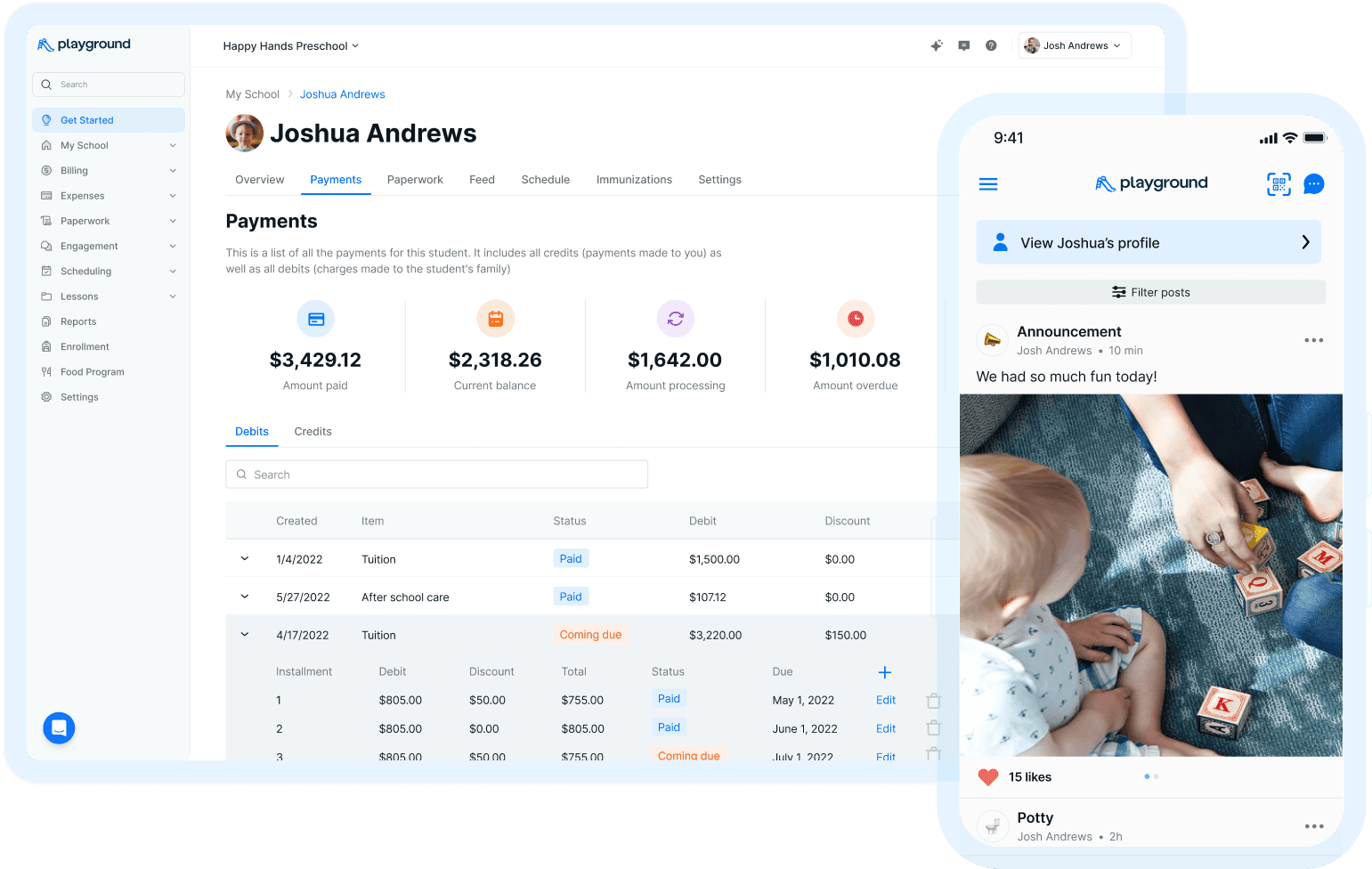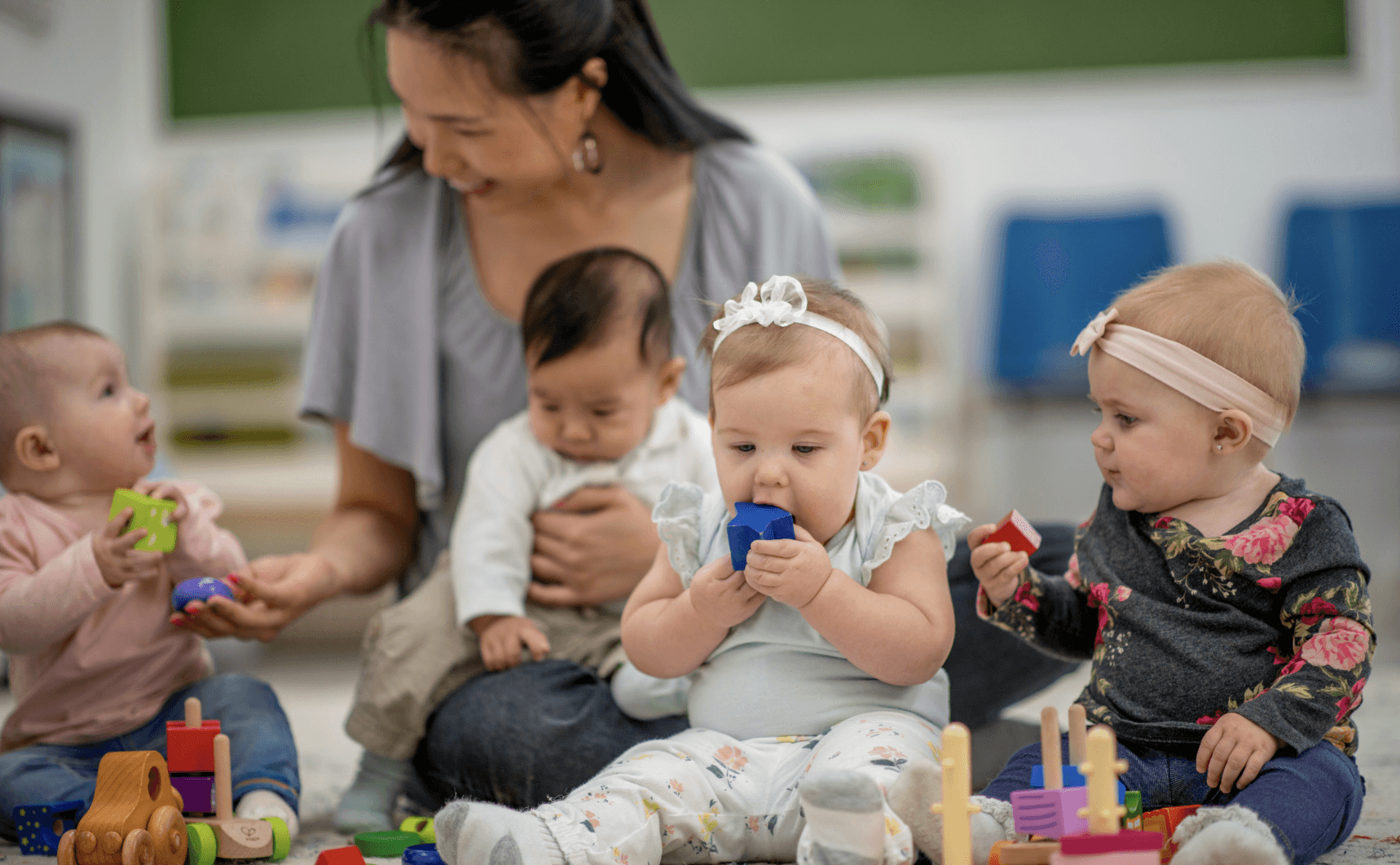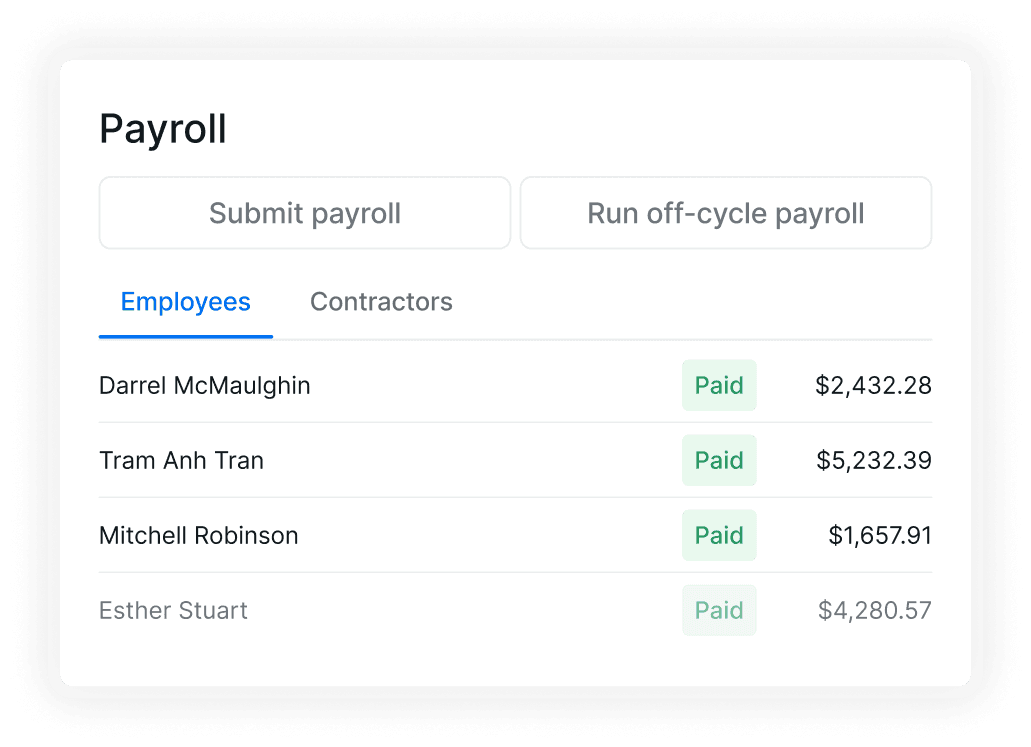What is the Right Staff-to-Child Ratio for Childcare?


Daniel McDonnell
5 min read

Make your families & teachers happier
All-in-one child care management platform with billing, attendance, registration, communication, payroll, and more!
5.0 Rating

Make your families & teachers happier
All-in-one child care management platform with billing, attendance, registration, communication, payroll, and more!
5.0 Rating
Staff-to-child ratios are guidelines for appropriately staffing your childcare centers. Defining your staffing ratios is a crucial step in ensuring that children receive adequate attention and are learning in a safe, welcoming environment. Understanding how to run a daycare business effectively includes maintaining these ratios, as they dictate the level of care you can provide.
While there are regulations per state and recommendations depending on class size and age group, every childcare center’s staff-to-child ratio is unique and should be based on the specific children you serve, among other factors. Here’s a complete overview of childcare ratios with recommendations for finding the right one for your childcare operation.
Understanding regulatory guidelines for childcare ratios
Each state has their own regulatory guidelines for childcare ratios. While your approach to staffing may be unique to your childcare center, you’re still bound by these legal requirements.
State-by-state examples of childcare ratios
When making decisions about the ideal ratio for your childcare center, there are a few things to consider—one of which is your state’s regulations. For example, if you live in New York and have a daycare specializing in infant care, you’re required to have a trained staff member for every six children. On the other hand, if you run a Montessori school in California for children aged six to 12, you’ll need a trained staff member for every 14 students.
How ratios differ by age group
It's important to note that children of different ages need different daycare ratios to make sure they get the right amount of care and attention. Rule of thumb: younger children need more caretakers than their more mature counterparts. However, remember that every child is different and has unique needs, and this should be a guiding consideration as you decide what staff-to-child ratios make sense for your facility. As a starting point, take a look at this ratio-by-age chart from the National Association for the Education of Young Children (NAEYC).

Source: National Association for the Education of Young Children (NAEYC)
NAEYC, the north star of early childhood education, suggests a staff-to-child ratio of 1:4 for infants (under 12 months) and 1:6 for toddlers (12-36 months), with maximum group sizes of 8 and 12, respectively. These ratios allow caregivers to provide more individual attention to each child, which is critical during the early stages of development. Childcare.gov offers similar guidance, emphasizing the importance of low ratios for maintaining safety.
By following these guidelines, you can mitigate accidents, injuries, or neglect in your childcare center. Plus, the individualized care made possible by lower ratios has been shown to improve children’s readiness for school by promoting early language development, problem-solving skills, and emotional regulation.
The consequences of incorrect staff-to-child ratios
Incorrect childcare ratios can significantly disrupt operations and pose serious consequences for the safety, developmental benefits, and attention needs of the children. Here are some of the top risks that can arise from improperly staffing your program:
Incorrect ratio compromises child safety, leading to a higher risk of accidents, insufficient supervision, and emergencies being handled poorly.
Striking the wrong ratio can lead to less individualized attention for each child, negatively affecting emotional, social, and educational development.
Inadequate ratios can result in subpar learning outcomes, with teachers struggling to provide enough engagement or focused time for each child.
Avoid these consequences by giving ample thought to your staffing ratios and being open to iterating as needed. Of course, always be sure to remain compliant with your state’s regulations and recommendations.
Flexibility in staffing to achieve the ideal ratio
Childcare ratios aren’t one-size-fits-all, so it’s best to take a flexible approach to staffing numbers. As enrollment fluctuates and you learn individual child needs, you may find that you need to adjust your ratios. This is especially true for seasonal programs, drop-in daycare facilities, Montessori schools, and centers that offer extended hours.
Teacher’s aides and casual staff as supplemental support

In the event that your enrollment fluctuates over the course of the year and you can’t keep a consistent staff count, you should consider hiring teacher’s aides, casual staff, and floaters to supplement your full-time employees. This will allow you to maintain the same staff all year without overspending on personnel or falling short of child needs.
Adjusting ratios for special needs programs
When running a center that serves special needs children, the typical staffing recommendations are a little different. Oftentimes, children with differing abilities need more attention and advanced care, so there’s a need for 1:1 care. Whether your program is specifically designed to accommodate these children or they represent a portion of your enrollment, it’s essential to establish ratios that allow you to provide exceptional care, no matter what. This will build trust and inspire confidence in the families you care for.
Importance of ongoing staff training
With the perfectly dialed-in childcare ratio comes a strategy for ongoing staff training. As the needs of children change, your staff’s ability to meet them should evolve. You and your staff should constantly work towards being more prepared for challenging circumstances, incoming children, and evolving modalities for care. After all, parents and caretakers have entrusted you with their children and they expect the highest level of care.
The wrong ratio can result in inadequate care, diminished learning or development, and even accidents. When parents entrust you with their children, there’s no margin for error, which is why getting your child-to-staff ratios right is so important. Luckily, as long as you follow your local regulations and adapt your ratio based on the unique needs of the children you serve, you’ll be well on your way to the perfect childcare ratio.
Child-to-staff ratios are an important decision when opening a childcare program, but it’s only one piece of the puzzle. For a comprehensive guide, read How to Run a Daycare Business: A Complete Overview.
Staff-to-child ratios are guidelines for appropriately staffing your childcare centers. Defining your staffing ratios is a crucial step in ensuring that children receive adequate attention and are learning in a safe, welcoming environment. Understanding how to run a daycare business effectively includes maintaining these ratios, as they dictate the level of care you can provide.
While there are regulations per state and recommendations depending on class size and age group, every childcare center’s staff-to-child ratio is unique and should be based on the specific children you serve, among other factors. Here’s a complete overview of childcare ratios with recommendations for finding the right one for your childcare operation.
Understanding regulatory guidelines for childcare ratios
Each state has their own regulatory guidelines for childcare ratios. While your approach to staffing may be unique to your childcare center, you’re still bound by these legal requirements.
State-by-state examples of childcare ratios
When making decisions about the ideal ratio for your childcare center, there are a few things to consider—one of which is your state’s regulations. For example, if you live in New York and have a daycare specializing in infant care, you’re required to have a trained staff member for every six children. On the other hand, if you run a Montessori school in California for children aged six to 12, you’ll need a trained staff member for every 14 students.
How ratios differ by age group
It's important to note that children of different ages need different daycare ratios to make sure they get the right amount of care and attention. Rule of thumb: younger children need more caretakers than their more mature counterparts. However, remember that every child is different and has unique needs, and this should be a guiding consideration as you decide what staff-to-child ratios make sense for your facility. As a starting point, take a look at this ratio-by-age chart from the National Association for the Education of Young Children (NAEYC).

Source: National Association for the Education of Young Children (NAEYC)
NAEYC, the north star of early childhood education, suggests a staff-to-child ratio of 1:4 for infants (under 12 months) and 1:6 for toddlers (12-36 months), with maximum group sizes of 8 and 12, respectively. These ratios allow caregivers to provide more individual attention to each child, which is critical during the early stages of development. Childcare.gov offers similar guidance, emphasizing the importance of low ratios for maintaining safety.
By following these guidelines, you can mitigate accidents, injuries, or neglect in your childcare center. Plus, the individualized care made possible by lower ratios has been shown to improve children’s readiness for school by promoting early language development, problem-solving skills, and emotional regulation.
The consequences of incorrect staff-to-child ratios
Incorrect childcare ratios can significantly disrupt operations and pose serious consequences for the safety, developmental benefits, and attention needs of the children. Here are some of the top risks that can arise from improperly staffing your program:
Incorrect ratio compromises child safety, leading to a higher risk of accidents, insufficient supervision, and emergencies being handled poorly.
Striking the wrong ratio can lead to less individualized attention for each child, negatively affecting emotional, social, and educational development.
Inadequate ratios can result in subpar learning outcomes, with teachers struggling to provide enough engagement or focused time for each child.
Avoid these consequences by giving ample thought to your staffing ratios and being open to iterating as needed. Of course, always be sure to remain compliant with your state’s regulations and recommendations.
Flexibility in staffing to achieve the ideal ratio
Childcare ratios aren’t one-size-fits-all, so it’s best to take a flexible approach to staffing numbers. As enrollment fluctuates and you learn individual child needs, you may find that you need to adjust your ratios. This is especially true for seasonal programs, drop-in daycare facilities, Montessori schools, and centers that offer extended hours.
Teacher’s aides and casual staff as supplemental support

In the event that your enrollment fluctuates over the course of the year and you can’t keep a consistent staff count, you should consider hiring teacher’s aides, casual staff, and floaters to supplement your full-time employees. This will allow you to maintain the same staff all year without overspending on personnel or falling short of child needs.
Adjusting ratios for special needs programs
When running a center that serves special needs children, the typical staffing recommendations are a little different. Oftentimes, children with differing abilities need more attention and advanced care, so there’s a need for 1:1 care. Whether your program is specifically designed to accommodate these children or they represent a portion of your enrollment, it’s essential to establish ratios that allow you to provide exceptional care, no matter what. This will build trust and inspire confidence in the families you care for.
Importance of ongoing staff training
With the perfectly dialed-in childcare ratio comes a strategy for ongoing staff training. As the needs of children change, your staff’s ability to meet them should evolve. You and your staff should constantly work towards being more prepared for challenging circumstances, incoming children, and evolving modalities for care. After all, parents and caretakers have entrusted you with their children and they expect the highest level of care.
The wrong ratio can result in inadequate care, diminished learning or development, and even accidents. When parents entrust you with their children, there’s no margin for error, which is why getting your child-to-staff ratios right is so important. Luckily, as long as you follow your local regulations and adapt your ratio based on the unique needs of the children you serve, you’ll be well on your way to the perfect childcare ratio.
Child-to-staff ratios are an important decision when opening a childcare program, but it’s only one piece of the puzzle. For a comprehensive guide, read How to Run a Daycare Business: A Complete Overview.
Staff-to-child ratios are guidelines for appropriately staffing your childcare centers. Defining your staffing ratios is a crucial step in ensuring that children receive adequate attention and are learning in a safe, welcoming environment. Understanding how to run a daycare business effectively includes maintaining these ratios, as they dictate the level of care you can provide.
While there are regulations per state and recommendations depending on class size and age group, every childcare center’s staff-to-child ratio is unique and should be based on the specific children you serve, among other factors. Here’s a complete overview of childcare ratios with recommendations for finding the right one for your childcare operation.
Understanding regulatory guidelines for childcare ratios
Each state has their own regulatory guidelines for childcare ratios. While your approach to staffing may be unique to your childcare center, you’re still bound by these legal requirements.
State-by-state examples of childcare ratios
When making decisions about the ideal ratio for your childcare center, there are a few things to consider—one of which is your state’s regulations. For example, if you live in New York and have a daycare specializing in infant care, you’re required to have a trained staff member for every six children. On the other hand, if you run a Montessori school in California for children aged six to 12, you’ll need a trained staff member for every 14 students.
How ratios differ by age group
It's important to note that children of different ages need different daycare ratios to make sure they get the right amount of care and attention. Rule of thumb: younger children need more caretakers than their more mature counterparts. However, remember that every child is different and has unique needs, and this should be a guiding consideration as you decide what staff-to-child ratios make sense for your facility. As a starting point, take a look at this ratio-by-age chart from the National Association for the Education of Young Children (NAEYC).

Source: National Association for the Education of Young Children (NAEYC)
NAEYC, the north star of early childhood education, suggests a staff-to-child ratio of 1:4 for infants (under 12 months) and 1:6 for toddlers (12-36 months), with maximum group sizes of 8 and 12, respectively. These ratios allow caregivers to provide more individual attention to each child, which is critical during the early stages of development. Childcare.gov offers similar guidance, emphasizing the importance of low ratios for maintaining safety.
By following these guidelines, you can mitigate accidents, injuries, or neglect in your childcare center. Plus, the individualized care made possible by lower ratios has been shown to improve children’s readiness for school by promoting early language development, problem-solving skills, and emotional regulation.
The consequences of incorrect staff-to-child ratios
Incorrect childcare ratios can significantly disrupt operations and pose serious consequences for the safety, developmental benefits, and attention needs of the children. Here are some of the top risks that can arise from improperly staffing your program:
Incorrect ratio compromises child safety, leading to a higher risk of accidents, insufficient supervision, and emergencies being handled poorly.
Striking the wrong ratio can lead to less individualized attention for each child, negatively affecting emotional, social, and educational development.
Inadequate ratios can result in subpar learning outcomes, with teachers struggling to provide enough engagement or focused time for each child.
Avoid these consequences by giving ample thought to your staffing ratios and being open to iterating as needed. Of course, always be sure to remain compliant with your state’s regulations and recommendations.
Flexibility in staffing to achieve the ideal ratio
Childcare ratios aren’t one-size-fits-all, so it’s best to take a flexible approach to staffing numbers. As enrollment fluctuates and you learn individual child needs, you may find that you need to adjust your ratios. This is especially true for seasonal programs, drop-in daycare facilities, Montessori schools, and centers that offer extended hours.
Teacher’s aides and casual staff as supplemental support

In the event that your enrollment fluctuates over the course of the year and you can’t keep a consistent staff count, you should consider hiring teacher’s aides, casual staff, and floaters to supplement your full-time employees. This will allow you to maintain the same staff all year without overspending on personnel or falling short of child needs.
Adjusting ratios for special needs programs
When running a center that serves special needs children, the typical staffing recommendations are a little different. Oftentimes, children with differing abilities need more attention and advanced care, so there’s a need for 1:1 care. Whether your program is specifically designed to accommodate these children or they represent a portion of your enrollment, it’s essential to establish ratios that allow you to provide exceptional care, no matter what. This will build trust and inspire confidence in the families you care for.
Importance of ongoing staff training
With the perfectly dialed-in childcare ratio comes a strategy for ongoing staff training. As the needs of children change, your staff’s ability to meet them should evolve. You and your staff should constantly work towards being more prepared for challenging circumstances, incoming children, and evolving modalities for care. After all, parents and caretakers have entrusted you with their children and they expect the highest level of care.
The wrong ratio can result in inadequate care, diminished learning or development, and even accidents. When parents entrust you with their children, there’s no margin for error, which is why getting your child-to-staff ratios right is so important. Luckily, as long as you follow your local regulations and adapt your ratio based on the unique needs of the children you serve, you’ll be well on your way to the perfect childcare ratio.
Child-to-staff ratios are an important decision when opening a childcare program, but it’s only one piece of the puzzle. For a comprehensive guide, read How to Run a Daycare Business: A Complete Overview.
Playground is the only app directors need to run their early child care center. Playground manages marketing, registration, billing, attendance, communication, paperwork, payroll, and more for child care programs. 300,000+ directors, teachers, and families trust Playground to simplify their lives.
Learn more by scheduling a free personalized demo.
See what Playground can do for you
Learn how our top-rated child care management platform can make your families & teachers happier while lowering your costs



Related articles
Stay in the loop.
Sign up for Playground updates.
Stay in the loop.
Sign up for Playground updates.
Stay in the loop.
Sign up for the updates.
© 2025 Carline Inc. All rights reserved.

© 2025 Carline Inc. All rights reserved.

© 2025 Carline Inc. All rights reserved.

What is the Right Staff-to-Child Ratio for Childcare?
Published Oct 23, 2024
|


